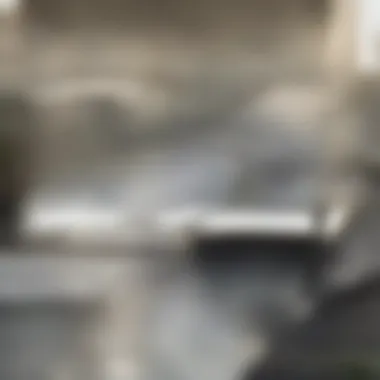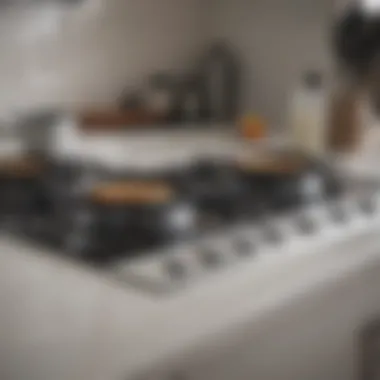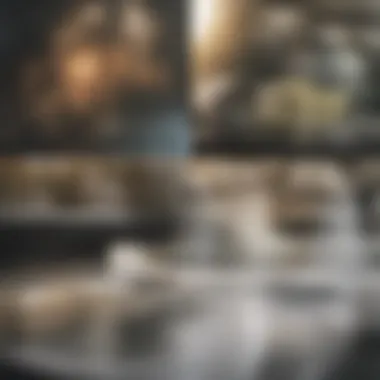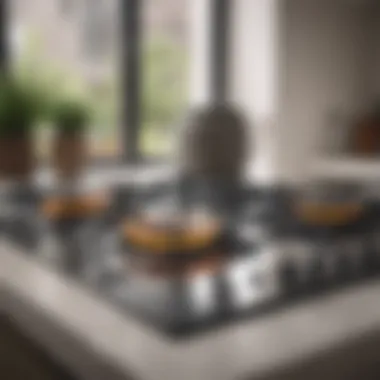Ultimate Guide to Cleaning White Glass Stove Tops


Intro
Cleaning white glass stove tops is a task that requires both precision and care. With their sleek surface and modern look, these stoves elevate any kitchen space, but they are prone to showing marks and stains. This comprehensive guide aims to demystify the process of cleaning and maintaining glass stove tops. Through a series of effective methods, recommended products, and preventative measures, this article will help ensure that your cooking surface remains both functional and aesthetically pleasing.
Understanding the unique qualities of white glass will be essential in keeping it pristine. As we navigate through different cleaning techniques, highlight recommended products to use, and explore preventative care tips, it is important to appreciate how each element contributes to the overall longevity and appeal of the stove top.
Maintaining the clarity and shine of white glass stove tops is more than a matter of aesthetics; it is also about cultivating a safe cooking environment. Therefore, this guide is structured to provide you with thorough insights and actionable advice, helping you cultivate a stove that is as visually striking as it is dependable.
Effective Cleaning Techniques
Cleaning a white glass stove top requires a dedicated approach, focusing on both routine maintenance and deep cleaning methods. By adopting the right techniques, it is possible to restore the surface without causing damage.
Routine Cleaning
- Daily Wipe Down: After every use, allow the stove to cool down, and use a damp cloth to wipe away food debris. This prevents buildup and minimizes stains.
- Gentle Cleaners: A mild dish soap diluted in water is often effective. Apply the solution using a soft sponge, ensuring no abrasive materials are used to avoid scratching the surface.
- Dry Completely: Finally, always dry the surface thoroughly to prevent water spots and streaks.
Deep Cleaning
Occasional deep cleaning is necessary to maintain your stove’s shine. Follow these steps for an effective cleaning session:
- Turn off the stove and ensure it is completely cool.
- Use a glass stove top cleaner, like Weiman or Cerama Bryte, which are specifically designed for glass. Apply a small amount to the surface.
- With a non-abrasive pad or cloth, gently scrub. Focus on stubborn spots, applying slight pressure as needed.
- Rinse with a damp cloth and dry the surface completely.
"Regular cleaning prevents long-term damage and keeps your glass stove top looking new."
Recommended Products
Investing in appropriate cleaning products can make the task simpler and more effective. Here are some recommended items:
- CeramaBryte Cooktop Cleaner: Effective for tough stains and safe for regular use.
- Weiman Glass Cooktop Cleaner: A dual action formula that cleans and protects.
- Magic Eraser: Good for removing various types of marks without harm to the surface.
Preventative Care Tips
Preventative care enhances the life of your white glass stove top.
- Avoid Heavy Pots: Placing extremely heavy cookware can cause cracks or scratches. Choose lighter pans where possible.
- Use Cookware with Smooth Bottoms: This reduces the risk of scratching the glass.
- Cover Burns Immediately: If something spills over, clean it immediately while the surface is still warm. This makes it easier to remove without sticking.
Maintaining a white glass stove top might seem daunting, but with the right approaches, it can be an effortless part of kitchen care. Regular attention and proper products will ensure that your stove continues to enhance your cooking experience.
The Unique Challenges of White Glass Stove Tops
White glass stove tops are known for their elegance and modern appeal, but they come with a set of challenges distinct from traditional stovetops. Knowing these challenges is essential for maintaining their appearance and functionality. The very nature of a white surface makes it susceptible to visible blemishes, which can detract from the overall aesthetic of your kitchen.
Understanding Stain Formation
Stains on white glass stove tops can arise from several sources. Cooking spills, grease, and food particles easily adhere to the surface due to heat and contact. These stains often penetrate the glass surface if not addressed promptly. As a result, understanding how stains form helps in devising effective cleaning strategies. For instance, burnt-on food can leave behind a residue that not only alters the color of the stove top but also can be quite tough to clean.
By addressing stains quickly, homeowners can prevent permanent damage and keep their stove tops looking pristine. Furthermore, cooking techniques that involve high temperatures can escalate the issue, causing more frequent discoloration.
Common Residue Types


Residue types found on white glass stove tops include burnt food, grease splatters, and mineral deposits from hard water. The most commonly seen residue is burnt food, often created when food spills over during cooking. This residue is usually dark and can ruin the uniformity of the white surface. Grease splatters, especially from frying or sautéing, can also contribute to an unsightly finish, making areas seem grimy. Meanwhile, mineral deposits often manifest from the use of low-quality water or excessive boiling, creating a cloudy appearance that is difficult to eliminate.
Awareness of these residue types allows users to tailor their cleaning methods accordingly. Knowing what to expect helps in selecting the right tools and products, enhancing the cleaning experience.
Essential Supplies for Cleaning
Cleaning white glass stove tops effectively requires specific supplies. These tools and materials help ensure that the surface retains its clarity and does not suffer from scratches or damage. Using the right cleaning supplies not only makes the process easier but also prolongs the life of the stove top. Let’s explore which elements are essential.
Recommended Cleaners
Choosing the right cleaner is crucial for preserving the integrity of the glass stove top. While many products can be harmful, some are specifically designed for this purpose. Here are a few recommended cleaners:
- Cerama Bryte: This cleaner is known for its gentle action. It effectively removes stains without scratching the surface.
- Bar Keepers Friend: This powdered cleaner is excellent for tough stains. When used correctly, it helps maintain shine.
- Dawn Dish Soap: For routine cleaning, a mild dish soap diluted with water can do wonders. It removes grease without harsh chemicals.
- White Vinegar: This natural cleaner can cut through grime and leave a fresh scent.
Always check labels to confirm the product is appropriate for glass surfaces.
Cleaning Tools
The cleaning tools you select can impact the overall cleaning result. Using abrasive materials can quickly lead to scratches and dullness. Here are the tools you will need:
- Soft microfiber cloths: They are safe and effective for wiping surfaces without leaving lint or scratches.
- Non-abrasive scrub pads: These pads can help with tougher stains, but make sure they are labeled as safe for glass.
- Spray bottle: This comes in handy for mixing cleaning solutions, particularly with vinegar or soap.
- Glass scraper: For extremely stubborn residue, a glass scraper can carefully remove debris without scratching the surface. Use it at a low angle for best results.
Investing in the right tools and cleaners can make a significant difference in the maintenance of your stove top. Regular use will help avoid the buildup of grime, which requires more intense cleaning methods.
Step-by-Step Cleaning Process
Cleaning a white glass stove top effectively requires a methodical approach. Following a step-by-step process ensures a thorough clean without damaging the surface. This section outlines critical elements to consider while cleaning, such as necessary supplies, techniques, and the order of operations. Implementing this process not only enhances the stove’s appearance but also contributes to its longevity.
Initial Surface Preparation
Before diving into the actual cleaning, it’s crucial to prepare the surface properly. Begin by ensuring the stove is cool to avoid burns. Remove any loose debris and food particles by wiping the surface with a soft cloth or paper towel. This is particularly important because trapped debris can scratch the glass when scrubbing. If there are larger items or burnt-on food, a plastic spatula can serve to gently lift these remnants without damaging the stove.
Inspect the surface for any areas that require more focus, such as discolored spots or heavier residues. Notably, using warm water on the cloth during the initial wipe can help in loosening stubborn particles, making further cleaning easier. A clean surface not only makes the subsequent steps more effective but also ensures that cleaning agents work on a clear area, improving the overall results.
Applying Cleaning Solutions
Choosing the right cleaning solution is vital for protecting the integrity of the glass. Common options include commercially available glass stove top cleaners, which are formulated specifically for this purpose, or simple solutions like a mixture of vinegar and water. To apply the cleaner, spray it evenly across the surface, ensuring it covers all areas. Allow the solution to sit for a few minutes. This dwell time helps to breakdown grime and stains, making them easier to remove.
When using a homemade solution, ensure it is effective against the types of residues noted in your initial assessment. For more serious stains, specialized products like Cerama Bryte or Weiman are advisable as they can penetrate tough stains without causing surface damage.
Scrubbing Techniques
Once the cleaning solution has had time to act, the next step is scrubbing. Use a non-abrasive scrub pad or cloth to gently scrub the surface. Move in circular motions to lift the grime effectively. Implementing light pressure is essential; excessive force can result in scratches. For corners and edges, a soft bristle brush or an old toothbrush can reach those tight spaces effectively.
Be cautious around any burnt areas, as they typically require more attention. If you encounter a particularly stubborn stain, apply more cleaner to that region and let it sit longer before scrubbing again. Regular cleaning will reduce the incidence of stubborn stains and, over time, protect the surface.
Rinsing and Drying
After scrubbing, it is important to rinse the stove top thoroughly. Use a clean damp cloth to wipe away any remaining cleaner and grime. This rinsing step is necessary to remove residues that can lead to streaks or spots if left behind. After rinsing, dry the surface with a separate soft, lint-free cloth.


If desired, a small amount of glass cleaner can be applied to enhance shine, but it must be followed by a thorough wipe to avoid leaving streaks.
In summary, this systematic approach ensures that your white glass stove top remains clean and well-maintained. Regular adherence to this process not only keeps your cooking surface visually appealing but also extends its lifespan.
Dealing with Stubborn Stains
Cleaning white glass stove tops can be a meticulous task. This is particularly true when faced with stubborn stains that resist traditional cleaning methods. Understanding how to effectively deal with these stains is crucial to maintaining the aesthetic appeal and functionality of your stove top. Stubborn stains can stem from a variety of sources including burnt-on food, grease, and even mineral deposits from hard water. Addressing these stains not only enhances the look of your cooking surface but also contributes to its longevity.
Identifying Stains by Type
Before undertaking any cleaning efforts, it is essential to identify the type of stain you are dealing with. Different stains may require specialized cleaning techniques or solutions. Common stain types include:
- Burnt Food Residue: Usually appears as a dark, hardened substance. It often results from food being cooked at high temperatures.
- Grease Stains: They often manifest as a hazy layer on the surface. Grease can accumulate over time due to splatters during cooking.
- Water Marks: These usually happen from spills where water evaporates, leaving mineral deposits behind.
- Scratches: Though not stains in a classic sense, scratches can capture dirt and appear as marks on the surface.
It is vital to evaluate the condition of your stove top closely. Not all stains respond to the same cleaning solutions, and recognizing their type can save time and effort in the long run.
Advanced Cleaning Solutions
Once you have identified the stain type, you can then select an appropriate cleaning solution to tackle it. Here are some advanced cleaning solutions tailored for different stain types:
- Baking Soda Paste: For burnt food, make a paste of baking soda and water. Apply it over the stain and let it sit for 15-20 minutes before scrubbing gently with a non-abrasive pad.
- Vinegar Solution: This is effective for grease stains. Mix equal parts white vinegar and water in a spray bottle. Spray onto the affected area, let it sit for a few minutes, then wipe it clean.
- Commercial Cleaners: Products like Bar Keepers Friend or Cerama Bryte can be very effective against tough stains. Follow the manufacturer's instructions closely to avoid damage to your glass top.
- Microfiber Cloths: When cleaning, always use a clean microfiber cloth. This minimizes the risk of scratches and helps to pick up dirt more effectively.
Always test a small, inconspicuous area before using any new cleaner on your stove top.
By employing these identified strategies, you improve your chances of restoring your stove top to its original condition. Regular cleaning, coupled with appropriate techniques, ensures your appliance remains a shining centerpiece in your kitchen.
Preventative Care for Longevity
Maintaining white glass stove tops is not merely about cleaning; it also involves taking proactive steps to prevent damage. Preventative care practices can greatly enhance the lifespan and aesthetics of these surfaces. White glass is especially susceptible to stains, scratches, and discoloration. Adopting strategies to mitigate these risks is essential for preserving the stove top’s appearance and functionality.
One major benefit of preventative care is that it saves time and effort in the long run. When a surface is neglected, stubborn stains and scratches often form, requiring intensive cleaning or, in some cases, professional repair. By implementing basic preventative measures, such as using the right cookware and cleaning frequently, the risk of permanent marks or damage is minimized.
Regular care allows your stove top to remain pristine, ensuring it is always ready for cooking. This not only enhances usability but also maintains the kitchen’s overall visual appeal. Here are several key elements to focus on when engaging in preventative care.
Avoiding Common Damage
To preserve the integrity of a white glass stove top, it is crucial to avoid common practices that lead to damage. One frequent source of damage comes from the type of cookware used. Heavy pots and pans can scratch the surface when dragged or dropped. Always lift pots instead of sliding them across the stove top. Moreover, cookware with rough bottoms should be avoided, as they can cause visible scratches even with light contact.
Another source of damage is high heat settings. Excessive heat can lead to discoloration, especially on lighter surfaces. Cooking at medium or low heat not only helps avoid this issue but also promotes energy efficiency. Furthermore, steam from boiling can collect grease and particles that may adhere to the surface. Covering pots with lids can help minimize steam accumulation, reducing the likelihood of undesirable marks.
Routine Maintenance Tips
Establishing a routine for maintaining your white glass stove top can significantly prolong its lifespan. Here are some practical maintenance tips to consider:
- Daily Cleaning: After each cooking session, wipe down the surface with a damp cloth. This removes food particles and prevents residue from hardening.
- Use Appropriate Cleaners: Choose non-abrasive cleaners specifically designed for glass surfaces. Products such as Cerama Bryte or Weiman Glass Cooktop Cleaner are often recommended.
- Avoid Harsh Chemicals: Stay away from bleach or ammonia-based cleaners, as they can erode the surface over time.
- Inspect Regularly: Keep an eye on any lingering stains or scratches. Address them promptly to prevent worsening.
- Follow Usage Guidelines: Always refer to the manufacturer's guidelines for care and cleaning. Understanding the stove top's specific needs is critical.
"Prevention is better than cure" is especially true for glass surfaces. Taking small yet consistent steps will yield great results over time.
By implementing these preventative care strategies, you ensure your white glass stove top remains clean and resembles new for years. Investing in routine maintenance is not just a chore; it is a commitment to maintaining the elegance and efficiency of your cooking space.


When to Seek Professional Help
Maintaining a white glass stove top involves a commitment to cleanliness, but sometimes it goes beyond standard home care. Recognizing when to enlist professional help is crucial for preserving your investment in kitchen appliances. This section discusses the signs that indicate a need for expert intervention and the considerations surrounding warranty and repair options.
Signs of Damage
Serious damage on a white glass stove top is not always easy to spot. However, certain indicators signal that it's time to consult a professional. Common signs of damage include:
- Cracks or Chips: Visible breaks in the glass are usually irreversible without professional assistance.
- Discoloration: Stubborn stains or a yellowish hue can signify deeper issues that routine cleaning cannot resolve.
- Uneven Heat Distribution: If you notice that some cooking zones heat inconsistently, the problem might lie beneath the surface.
As the homeowner, be attentive to these signs. Addressing issues promptly can prevent further deterioration. Ignoring minor flaws might lead to bigger, more costly repairs later.
Understanding Warranty and Repair Options
Before seeking professional service, it is wise to review the warranty provided by the manufacturer of your stove top. Many brands offer limited warranties that cover specific repairs or replacements. Some points to consider include:
- Warranty Duration: Know how long the warranty lasts and if the reported issues fall under its coverage.
- Repair Policies: Manufacturers typically outline authorized service centers where you should seek help.
- Expenses: Determine whether the warranty covers parts, labor, or both.
Ultimately, understanding your warranty can save money and ensure that your stove top is repaired correctly. Consider contacting customer support of brands like Whirlpool or Frigidaire for detailed guidance.
Consulting a professional can provide peace of mind and a solution tailored to your stove's specific needs.
Choosing to seek help is a prudent step for maintaining the quality and longevity of white glass stove tops. Identifying sings of damage and knowing your warranty details can lead to effective resolutions.
Frequently Asked Questions
The section on frequently asked questions serves an important purpose in the narrative of cleaning white glass stove tops. Addressing common inquiries helps clarify misconceptions and provide practical solutions. Since these surfaces can be sensitive to cleaning methods and products, understanding what is permissible and effective becomes crucial for maintaining their aesthetic and functional qualities. This section aims to empower readers with knowledge while also offering concise responses based on best practices and expert recommendations.
Can use abrasive cleaners?
Using abrasive cleaners on white glass stove tops is generally not recommended. This type of surface is prone to scratching, which can lead to permanent damage. Abrasive materials can create micro-scratches that compromise both the appearance and integrity of the stove top. Instead, it is best to opt for gentle, non-abrasive cleaners specifically formulated for glass surfaces. These cleaners will effectively remove grime and stains without causing scratches.
Here are some considerations:
- Type of Cleaners: Look for products labeled as safe for glass or ceramic surfaces.
- Application Method: Use soft cloths or sponges that do not contain abrasive particles.
- Frequency of Cleaning: Regular maintenance prevents the buildup of tough stains, reducing the need for aggressive cleaning.
How often should clean my stove top?
Cleaning frequency depends on usage and cooking habits. However, it is advisable to clean your white glass stove top after each use. This not only maintains its shine but also prevents food residues from hardening, making them more difficult to remove later. A quick wipe-down with a soft cloth and a mild cleaner can go a long way.
Consider the following:
- Daily Cleaning: Essential for households that cook frequently to avoid stains.
- Deep Cleaning: Consider performing a thorough cleaning once a week for a polished look.
- Consider Usage: If you cook with a lot of grease or sauces, more frequent cleaning can help maintain clarity.
Implementing these practices will ensure that your stove top remains in excellent condition, making it both a functional and appealing centerpiece in your kitchen.
The End
Cleaning white glass stove tops is not merely a chore; it serves as a crucial part of home maintenance that can affect both the aesthetic appeal and functionality of your kitchen space. A clean stove top contributes significantly to the overall look of your kitchen, enhancing its modern feel and inviting atmosphere. Given that kitchen surfaces are often subject to spills and stains from cooking, it becomes essential to understand effective cleaning methods.
The approach outlined in this guide emphasizes the importance of using the right supplies and techniques. Utilizing non-abrasive cleaners and soft cloths prevents scratches and preserves the glass surface's clarity, ensuring that it remains a focal point of your kitchen decor. Moreover, regular maintenance routines can extend the life of your stove top, saving you potential repair costs in the long run.
One must also be attuned to the signs of damage. When discoloration or scratches appear, recognizing these issues early can facilitate timely interventions, helping to avoid more costly repairs or replacements. The integration of preventative care tips not only enhances the immediate appearance of the stove but also fosters a sustainable approach toward kitchen care.
In summary, this comprehensive guide provides homeowners with the tools and knowledge necessary to maintain white glass stove tops effectively. Emphasizing both aesthetic and functional aspects will allow for a cooking space that is both inviting and practical. The insights shared here ensure that you can keep your glass stove top looking its best for years to come.







